导乐分娩应急预案及流程
导乐陪伴的应急处理预案
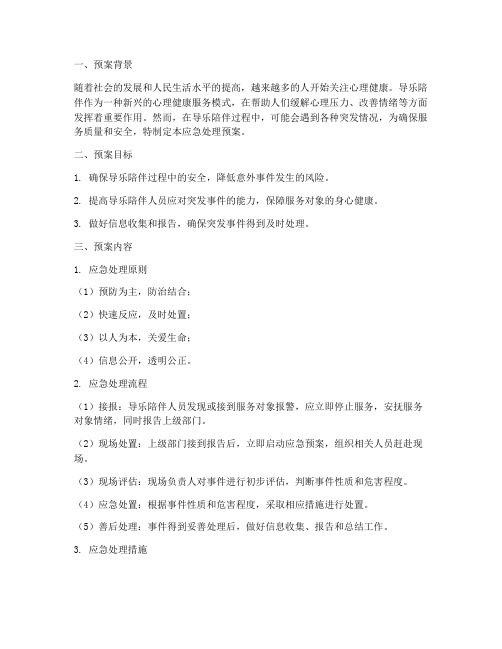
一、预案背景随着社会的发展和人民生活水平的提高,越来越多的人开始关注心理健康。
导乐陪伴作为一种新兴的心理健康服务模式,在帮助人们缓解心理压力、改善情绪等方面发挥着重要作用。
然而,在导乐陪伴过程中,可能会遇到各种突发情况,为确保服务质量和安全,特制定本应急处理预案。
二、预案目标1. 确保导乐陪伴过程中的安全,降低意外事件发生的风险。
2. 提高导乐陪伴人员应对突发事件的能力,保障服务对象的身心健康。
3. 做好信息收集和报告,确保突发事件得到及时处理。
三、预案内容1. 应急处理原则(1)预防为主,防治结合;(2)快速反应,及时处置;(3)以人为本,关爱生命;(4)信息公开,透明公正。
2. 应急处理流程(1)接报:导乐陪伴人员发现或接到服务对象报警,应立即停止服务,安抚服务对象情绪,同时报告上级部门。
(2)现场处置:上级部门接到报告后,立即启动应急预案,组织相关人员赶赴现场。
(3)现场评估:现场负责人对事件进行初步评估,判断事件性质和危害程度。
(4)应急处置:根据事件性质和危害程度,采取相应措施进行处置。
(5)善后处理:事件得到妥善处理后,做好信息收集、报告和总结工作。
3. 应急处理措施(1)服务对象情绪安抚:导乐陪伴人员应掌握一定的心理危机干预技巧,安抚服务对象情绪,避免事态扩大。
(2)现场安全控制:现场负责人应组织人员对现场进行安全控制,确保人员安全。
(3)医疗救治:如服务对象出现身体不适,立即联系医疗机构进行救治。
(4)心理干预:如服务对象出现心理危机,及时联系专业心理人员进行干预。
(5)信息报告:向上级部门报告事件情况,包括事件性质、危害程度、处置措施等。
四、预案培训1. 定期对导乐陪伴人员进行应急处理培训,提高其应对突发事件的能力。
2. 组织应急演练,检验预案的有效性和可操作性。
五、预案修订本预案自发布之日起实施,如遇重大政策调整或实际情况发生变化,及时修订。
六、预案监督1. 成立应急处理监督小组,负责监督预案的执行情况。
紧急分娩的应急预案

一、背景为了保障母婴安全,提高医疗质量,降低孕产妇死亡率,确保新生儿健康,特制定本应急预案。
二、适用范围本预案适用于医院内发生的紧急分娩情况,包括孕产妇在分娩过程中出现的各种突发状况。
三、组织机构及职责1. 成立紧急分娩领导小组,负责制定、实施、监督本预案。
2. 医院产科为紧急分娩的主责任科室,负责组织、协调、实施紧急分娩工作。
3. 相关科室(如麻醉科、儿科、急诊科等)应按照预案要求,做好配合和支持工作。
四、应急预案流程1. 发现紧急情况(1)接诊护士或医生发现孕产妇出现紧急情况时,应立即向产科值班医生报告。
(2)值班医生接到报告后,应立即进行初步评估,判断是否为紧急分娩情况。
2. 启动应急预案(1)若确定为紧急分娩情况,产科值班医生应立即启动应急预案,并向医院紧急分娩领导小组报告。
(2)紧急分娩领导小组接到报告后,应立即组织相关人员到场,协调各部门开展紧急救治工作。
3. 紧急救治(1)产科值班医生应迅速进行病情评估,决定是否进行紧急剖宫产。
(2)若需进行紧急剖宫产,麻醉科应迅速进行麻醉,儿科医生应做好新生儿窒息抢救准备。
(3)产科、麻醉科、儿科等相关科室密切配合,确保手术顺利进行。
4. 术后观察与护理(1)术后,产科医生应密切观察孕产妇生命体征,及时发现并处理并发症。
(2)新生儿应由儿科医生进行观察与护理,确保新生儿生命安全。
5. 信息报告(1)紧急分娩情况发生后,产科值班医生应立即向医院相关部门报告。
(2)医院相关部门应按照规定程序,向上级卫生行政部门报告。
五、应急预案保障措施1. 加强人员培训(1)定期组织产科、麻醉科、儿科等相关科室进行紧急分娩应急预案培训。
(2)提高医护人员应对紧急分娩情况的能力,确保能够迅速、准确地进行救治。
2. 完善设备设施(1)确保产科、麻醉科、儿科等相关科室的设备设施齐全、完好。
(2)定期对设备设施进行维护、检修,确保其在紧急情况下能够正常使用。
3. 优化资源配置(1)合理配置产科、麻醉科、儿科等相关科室的人力、物力资源。
院前分娩应急预案

一、预案背景随着我国人口增长和家庭结构的变化,分娩需求不断增加。
然而,由于种种原因,部分孕产妇在分娩过程中可能面临突发状况,如分娩并发症、胎盘剥离、羊水栓塞等,对母婴生命安全构成威胁。
为了保障孕产妇及新生儿的安全,提高院前分娩应急处置能力,特制定本预案。
二、预案目标1. 提高院前分娩应急处置能力,确保孕产妇及新生儿生命安全。
2. 规范院前分娩流程,提高救治成功率。
3. 加强医护人员培训,提高应急处置水平。
三、预案内容1. 院前分娩评估(1)孕产妇基本情况:年龄、孕周、孕期并发症、既往病史等。
(2)分娩征兆:宫缩、见红、破水等。
(3)现场环境:交通便利、通讯畅通、医疗设备齐全。
2. 院前分娩处置流程(1)接到呼救电话后,立即启动应急预案,指派医护人员出诊。
(2)出诊前,详细了解孕产妇情况,准备所需医疗设备和药品。
(3)到达现场后,迅速评估孕产妇病情,采取必要的急救措施。
(4)对出现并发症的孕产妇,立即进行现场急救,如吸氧、止血、建立静脉通路等。
(5)在确保孕产妇及新生儿安全的前提下,迅速将孕产妇转运至医院。
3. 院前分娩应急处置措施(1)宫缩过强:给予宫缩抑制剂,减轻宫缩强度。
(2)胎盘剥离:进行胎盘剥离术,必要时进行子宫切除术。
(3)羊水栓塞:立即进行抗过敏、抗休克、面罩吸氧等抢救措施,必要时进行心肺复苏。
(4)胎儿窘迫:给予吸氧、促进胎心恢复等处理。
4. 院前分娩转运流程(1)选择合适的交通工具,确保孕产妇及新生儿安全。
(2)途中密切观察孕产妇及新生儿生命体征,必要时进行急救处理。
(3)到达医院后,迅速将孕产妇及新生儿交由产科医护人员接手。
四、预案实施与培训1. 定期组织医护人员进行院前分娩应急处置培训,提高应急处置能力。
2. 加强与医院产科、麻醉科、新生儿科等科室的沟通与协作,确保院前、院内救治无缝衔接。
3. 定期对预案进行修订和完善,确保预案的科学性和实用性。
五、预案监督与评估1. 建立院前分娩应急处置监督机制,确保预案得到有效执行。
导乐分娩服务应急问题处理
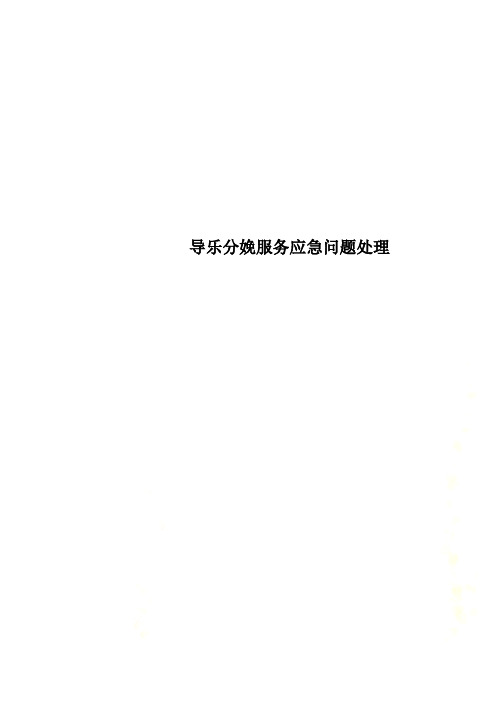
导乐分娩服务应急问题处理导乐分娩服务应急问题处理1、产妇来到陌生的待产室,会因人生地不熟而感到孤单、恐惧、紧张和焦虑,作为导乐师,我们应该如何向产妇介绍自己,并得到产妇的信任?答:做自我介绍需注意:(语气:亲切、自然;语言口语化更亲切,应让产妇感觉受到尊重。
表情:面带微笑,与产妇有眼神交流;动作:端庄、大方,可向产妇略微点头问候;)导乐师要亲切的与产妇打招呼:“您好,我是您的导乐师××,一直到您生完我都会陪在您身边的,有什么需要都可以跟我说(边介绍,边帮产妇拿东西,服务主动,更能拉近双方的距离)。
”语言示例:导乐师:您好!我是您的导乐师XX。
医生已经检查过了,您条件很好,可以自己生。
自己生,肯定会很疼,但这样对您和宝宝都好。
不过您也不用担心,我会一直陪着您,到时候还有导乐仪帮您镇痛,用上后就不那么疼了。
它是一种绿色分娩镇痛法,非药物、无创伤,对您和宝宝一点副作用都没有。
还能帮您缩短产程。
2、导乐师是做什么的?答:感谢您对导乐的认可,在您的待产过程中,我们会让您在一个快乐、轻松、舒适的状态下等待宝宝出生。
您有什么需求都可以告知我们,我们会尽全力给你提供最人性化的服务。
3、产妇询问:我们半夜生孩子,你们也在吗?这时我们该如何回答?答:我们24小时都有导乐师值班,请您放心4、导乐师什么时候下班啊?下一个陪我的是谁啊?答:一直到您的宝宝出生,都是由我来陪伴您的,我们是一对一服务,中间不换人的。
5、做自我介绍的同时,产妇面临宫缩痛,我们该如何处理?答:导乐师应与产妇平视或低于产妇视线进行目光交流,暂停自我介绍,采用非语言交流技巧(如肌肤接触,当产妇面临宫缩痛时,如果导乐师可以紧握她的手,并为她擦汗,抚摸他的头发,产妇会很有安全感,消除紧张情绪并顺利分娩)指导产妇呼吸及身体放松。
6、产妇询问“我这么疼,什么时候可以见到宝宝”,这时我们该如何回答?答:很好,我知道您很疼,(不管服务对象的想法如何错误,都要使用表扬和鼓励的方法,粗暴的对待服务对象,会打击她们寻求帮助的积极性。
产科应急分娩处置预案

一、预案目的为确保孕产妇、胎儿及新生儿在分娩过程中的安全,降低孕产妇及新生儿死亡率,提高产科医疗服务质量,特制定本预案。
二、适用范围本预案适用于我院产科所有孕产妇,特别是高危孕产妇及急产孕产妇。
三、组织架构1.成立产科应急分娩处置领导小组,由产科主任担任组长,成员包括产科医师、助产士、护士、麻醉科医师等。
2.设立产科应急分娩处置小组,负责具体实施应急分娩处置工作。
四、应急流程1.发现急产孕产妇:(1)立即告知产科值班医师,通知产科应急分娩处置小组。
(2)产科值班医师迅速到达现场,评估孕产妇及胎儿情况。
(3)产科应急分娩处置小组立即到位,协助产科值班医师进行应急处理。
2.评估孕产妇及胎儿情况:(1)检查孕产妇生命体征,包括心率、血压、呼吸等。
(2)观察胎儿宫缩、胎心、胎位等情况。
(3)判断孕产妇及胎儿是否处于危急状态。
3.应急处理:(1)若孕产妇及胎儿处于危急状态,立即进行紧急剖宫产。
(2)若孕产妇及胎儿情况稳定,协助助产士进行分娩。
(3)在分娩过程中,密切关注孕产妇及胎儿情况,确保安全。
4.产后处理:(1)协助助产士对新生儿进行初步护理。
(2)观察孕产妇生命体征,包括心率、血压、呼吸等。
(3)进行产后检查,确保孕产妇及新生儿安全。
五、注意事项1.加强产科值班医师、助产士、护士、麻醉科医师等人员的应急处理能力培训。
2.确保产科应急物资充足,包括药品、器械、消毒用品等。
3.加强与其他科室的沟通与协作,确保在应急情况下能够及时得到支持。
4.做好孕产妇及家属的沟通工作,告知应急处理措施及可能的风险。
六、预案更新与实施1.本预案自发布之日起实施,并根据实际情况进行修订。
2.产科应急分娩处置领导小组负责监督本预案的实施,确保各项措施落实到位。
3.定期对产科应急分娩处置工作进行总结、评估,不断优化预案内容。
通过本预案的实施,提高我院产科应急处理能力,确保孕产妇、胎儿及新生儿在分娩过程中的安全,降低孕产妇及新生儿死亡率,提高产科医疗服务质量。
导乐陪伴分娩应急预案

一、目的为确保产妇在分娩过程中得到及时、有效、安全的护理,预防和处理分娩过程中可能出现的各种风险,提高分娩质量,特制定本应急预案。
二、适用范围本预案适用于所有接受导乐陪伴分娩的产妇。
三、组织机构1. 成立导乐陪伴分娩应急预案领导小组,负责应急预案的制定、实施和监督。
2. 设立导乐陪伴分娩应急小组,负责具体实施应急预案。
四、应急预案内容1. 产妇入院评估(1)对产妇进行全面评估,包括:孕周、体重、血压、胎心率、宫缩频率、胎位等。
(2)评估产妇及家属的心理状态,了解产妇对分娩的期望和担忧。
2. 分娩过程监控(1)密切观察产妇宫缩情况,监测胎心率。
(2)根据产妇宫缩频率和强度,调整导乐陪伴策略。
(3)确保产妇在分娩过程中保持舒适体位,减轻疼痛。
3. 分娩风险预警与处理(1)预警:产妇出现以下情况时,应立即启动应急预案:- 宫缩异常:如宫缩过强、过弱、不规律等;- 胎心率异常:如胎心率过快、过慢或不规则;- 胎位异常:如臀位、横位等;- 产妇出现异常出血、头晕、恶心、呕吐等症状。
(2)处理:- 立即通知产科医生;- 采取相应措施,如调整体位、给予镇痛药物等;- 协助医生进行紧急处理,如剖宫产、产钳助产等。
4. 产后护理(1)观察产妇生命体征,包括:血压、脉搏、呼吸、体温等。
(2)评估产妇宫缩恢复情况,预防产后出血。
(3)指导产妇进行母乳喂养,促进子宫收缩。
(4)关注产妇心理状态,提供心理支持。
五、应急预案实施1. 应急小组接到预警信息后,立即启动应急预案。
2. 应急小组根据预警情况,采取相应措施,确保产妇安全。
3. 应急小组及时向上级领导和相关部门汇报,确保信息畅通。
4. 应急预案结束后,对事件进行总结和分析,提出改进措施。
六、应急预案的修订1. 根据实际情况,定期修订应急预案。
2. 对新出现的风险因素,及时补充到应急预案中。
3. 加强应急预案的宣传和培训,提高全员应对突发事件的能力。
本预案自发布之日起实施,由导乐陪伴分娩应急预案领导小组负责解释。
分娩前应急处理预案

一、预案目的为确保产妇及胎儿在分娩过程中的安全,提高分娩质量,减少分娩风险,特制定本预案。
本预案旨在明确分娩前应急处理流程,提高医护人员应对突发事件的应急能力,保障母婴安全。
二、预案适用范围本预案适用于所有即将分娩的产妇,包括自然分娩和剖宫产。
三、预案内容1. 分娩前准备工作(1)医护人员对产妇进行全面评估,了解其基本情况,包括年龄、孕周、体重、血压、血型等。
(2)做好产前检查,监测胎儿宫内情况,确保胎儿健康。
(3)告知产妇分娩过程可能出现的风险,提高产妇及家属的应对能力。
(4)做好待产包的准备,包括分娩所需物品、产妇及家属的生活用品等。
2. 分娩征兆及应急处理(1)宫缩:当产妇出现规律宫缩,每隔5-6分钟一次,每次持续30秒以上时,应立即通知医护人员。
(2)破水:当产妇出现破水现象时,应立即采取以下措施:①保持平躺,防止羊水流失过多;②通知医护人员;③做好消毒工作,防止感染。
(3)出血:当产妇出现阴道出血时,应立即采取以下措施:①保持平躺,减少出血;②通知医护人员;③根据出血情况,可能需要输血。
3. 分娩当日应急处理(1)分娩过程中,如出现胎儿宫内窘迫、胎盘早剥、羊水栓塞等紧急情况,应立即启动应急预案。
(2)医护人员应迅速评估产妇及胎儿情况,采取相应措施,确保母婴安全。
(3)若需要剖宫产,应立即通知手术室,做好术前准备。
4. 产后应急处理(1)产后两小时内,医护人员应密切观察产妇生命体征,确保产妇安全。
(2)如出现产后出血、产后感染等情况,应立即采取相应措施,防止病情恶化。
四、预案实施与培训1. 医院应定期组织医护人员进行应急处理培训,提高其应对突发事件的能力。
2. 医护人员应熟悉本预案内容,确保在关键时刻能够迅速采取有效措施。
3. 医院应定期进行应急演练,检验预案的有效性。
五、预案修订本预案自发布之日起实施,如遇政策调整或实际情况变化,应及时修订。
六、预案监督与考核1. 医院应设立应急处理监督小组,负责监督本预案的实施。
孕妇分娩应急预案范文
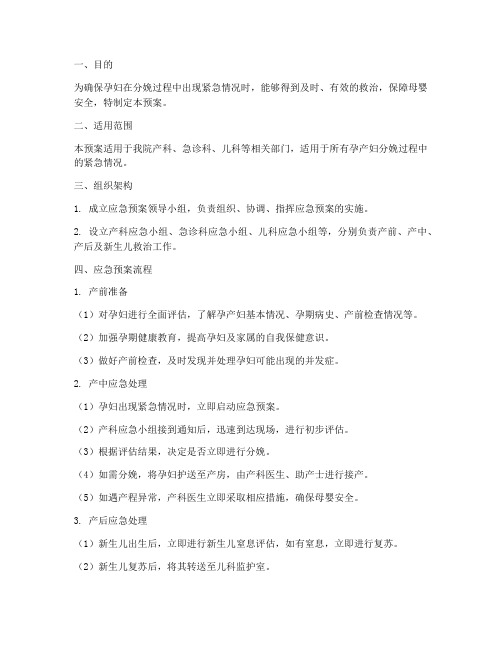
一、目的为确保孕妇在分娩过程中出现紧急情况时,能够得到及时、有效的救治,保障母婴安全,特制定本预案。
二、适用范围本预案适用于我院产科、急诊科、儿科等相关部门,适用于所有孕产妇分娩过程中的紧急情况。
三、组织架构1. 成立应急预案领导小组,负责组织、协调、指挥应急预案的实施。
2. 设立产科应急小组、急诊科应急小组、儿科应急小组等,分别负责产前、产中、产后及新生儿救治工作。
四、应急预案流程1. 产前准备(1)对孕妇进行全面评估,了解孕产妇基本情况、孕期病史、产前检查情况等。
(2)加强孕期健康教育,提高孕妇及家属的自我保健意识。
(3)做好产前检查,及时发现并处理孕妇可能出现的并发症。
2. 产中应急处理(1)孕妇出现紧急情况时,立即启动应急预案。
(2)产科应急小组接到通知后,迅速到达现场,进行初步评估。
(3)根据评估结果,决定是否立即进行分娩。
(4)如需分娩,将孕妇护送至产房,由产科医生、助产士进行接产。
(5)如遇产程异常,产科医生立即采取相应措施,确保母婴安全。
3. 产后应急处理(1)新生儿出生后,立即进行新生儿窒息评估,如有窒息,立即进行复苏。
(2)新生儿复苏后,将其转送至儿科监护室。
(3)对产妇进行产后检查,如发现出血、休克等并发症,立即进行抢救。
4. 紧急情况处理(1)如遇孕妇发生急产,立即启动应急预案,产科医生、助产士、儿科医生迅速到位。
(2)孕妇在救护车上分娩,立即将产妇及新生儿转移到抢救室进行监护观察。
(3)产科、儿科医生对产妇及新生儿进行进一步评估救治。
(4)开通绿色通道,为产妇及新生儿办理住院手续。
五、应急物资及设备1. 产科:产包、车床、新生儿复苏设备、抢救药品等。
2. 急诊科:急救药品、抢救设备、监护设备等。
3. 儿科:新生儿复苏设备、监护设备、抢救药品等。
六、培训与演练1. 定期组织医护人员进行应急预案培训,提高应急处理能力。
2. 定期开展应急预案演练,检验预案的可行性和实用性。
3. 对演练中发现的问题进行总结,不断完善应急预案。
导乐分娩应急预案及流程
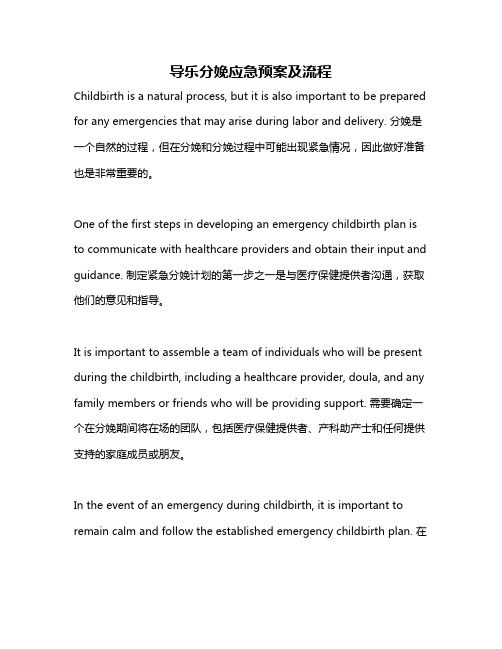
导乐分娩应急预案及流程Childbirth is a natural process, but it is also important to be prepared for any emergencies that may arise during labor and delivery. 分娩是一个自然的过程,但在分娩和分娩过程中可能出现紧急情况,因此做好准备也是非常重要的。
One of the first steps in developing an emergency childbirth plan is to communicate with healthcare providers and obtain their input and guidance. 制定紧急分娩计划的第一步之一是与医疗保健提供者沟通,获取他们的意见和指导。
It is important to assemble a team of individuals who will be present during the childbirth, including a healthcare provider, doula, and any family members or friends who will be providing support. 需要确定一个在分娩期间将在场的团队,包括医疗保健提供者、产科助产士和任何提供支持的家庭成员或朋友。
In the event of an emergency during childbirth, it is important to remain calm and follow the established emergency childbirth plan. 在分娩期间如果发生紧急情况,保持冷静并按照已制定的紧急分娩计划行事是非常重要的。
Key components of an emergency childbirth plan include identifying potential risks, outlining specific procedures to follow in the event of an emergency, and ensuring that all individuals involved are aware of their roles and responsibilities. 紧急分娩计划的关键组成部分包括确定潜在风险、概述在紧急情况下要遵循的具体程序,以及确保所有参与方都清楚他们的角色和责任。
分娩应急预案
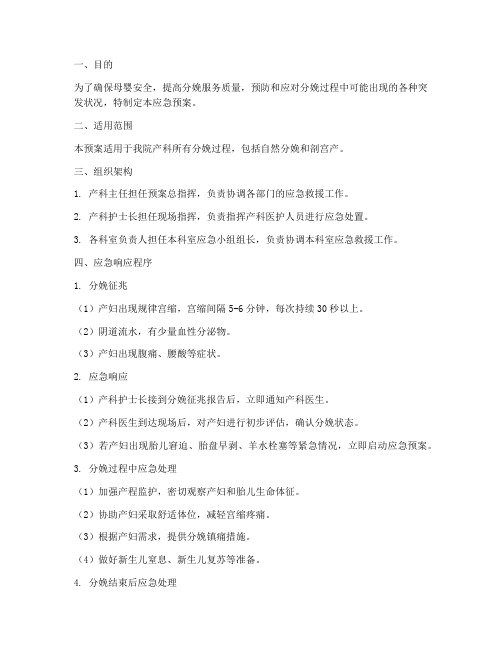
一、目的为了确保母婴安全,提高分娩服务质量,预防和应对分娩过程中可能出现的各种突发状况,特制定本应急预案。
二、适用范围本预案适用于我院产科所有分娩过程,包括自然分娩和剖宫产。
三、组织架构1. 产科主任担任预案总指挥,负责协调各部门的应急救援工作。
2. 产科护士长担任现场指挥,负责指挥产科医护人员进行应急处置。
3. 各科室负责人担任本科室应急小组组长,负责协调本科室应急救援工作。
四、应急响应程序1. 分娩征兆(1)产妇出现规律宫缩,宫缩间隔5-6分钟,每次持续30秒以上。
(2)阴道流水,有少量血性分泌物。
(3)产妇出现腹痛、腰酸等症状。
2. 应急响应(1)产科护士长接到分娩征兆报告后,立即通知产科医生。
(2)产科医生到达现场后,对产妇进行初步评估,确认分娩状态。
(3)若产妇出现胎儿窘迫、胎盘早剥、羊水栓塞等紧急情况,立即启动应急预案。
3. 分娩过程中应急处理(1)加强产程监护,密切观察产妇和胎儿生命体征。
(2)协助产妇采取舒适体位,减轻宫缩疼痛。
(3)根据产妇需求,提供分娩镇痛措施。
(4)做好新生儿窒息、新生儿复苏等准备。
4. 分娩结束后应急处理(1)对产妇进行产后检查,确保母婴安全。
(2)对新生儿进行Apgar评分,评估新生儿状况。
(3)做好产妇和新生儿的护理工作。
五、应急处置措施1. 胎儿窘迫(1)立即给予吸氧,调整产妇体位。
(2)若情况严重,考虑剖宫产。
2. 胎盘早剥(1)立即进行手术,取出胎儿。
(2)术中密切观察产妇生命体征,做好输血准备。
3. 羊水栓塞(1)立即进行抗过敏、抗休克、面罩吸氧等抢救措施。
(2)若情况严重,考虑剖宫产。
4. 新生儿窒息(1)立即进行新生儿复苏。
(2)做好新生儿监护,防止并发症。
六、培训和演练1. 定期组织产科医护人员进行应急预案培训。
2. 每年至少进行一次应急演练,提高应急处置能力。
七、总结本预案旨在提高我院产科分娩服务质量,确保母婴安全。
各级医护人员应认真贯彻执行,提高应急处置能力,为母婴健康保驾护航。
紧急处理分娩的应急预案
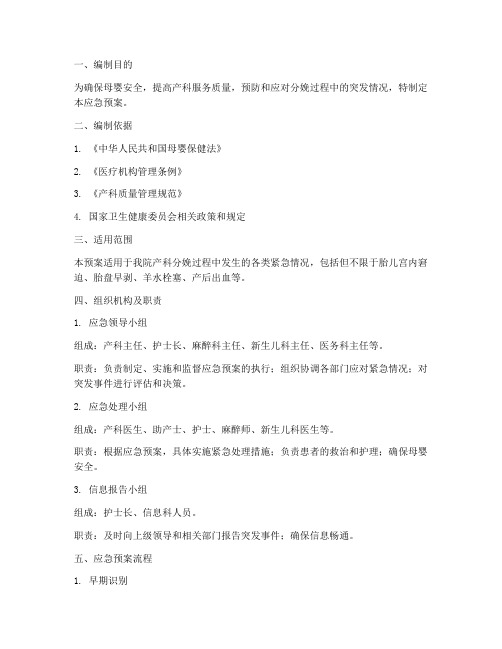
一、编制目的为确保母婴安全,提高产科服务质量,预防和应对分娩过程中的突发情况,特制定本应急预案。
二、编制依据1. 《中华人民共和国母婴保健法》2. 《医疗机构管理条例》3. 《产科质量管理规范》4. 国家卫生健康委员会相关政策和规定三、适用范围本预案适用于我院产科分娩过程中发生的各类紧急情况,包括但不限于胎儿宫内窘迫、胎盘早剥、羊水栓塞、产后出血等。
四、组织机构及职责1. 应急领导小组组成:产科主任、护士长、麻醉科主任、新生儿科主任、医务科主任等。
职责:负责制定、实施和监督应急预案的执行;组织协调各部门应对紧急情况;对突发事件进行评估和决策。
2. 应急处理小组组成:产科医生、助产士、护士、麻醉师、新生儿科医生等。
职责:根据应急预案,具体实施紧急处理措施;负责患者的救治和护理;确保母婴安全。
3. 信息报告小组组成:护士长、信息科人员。
职责:及时向上级领导和相关部门报告突发事件;确保信息畅通。
五、应急预案流程1. 早期识别(1)助产士在产程中密切观察产妇和胎儿情况,及时发现异常。
(2)医生对疑似高危产妇进行评估,必要时启动应急预案。
2. 紧急处理(1)胎儿宫内窘迫1)给予吸氧、调整产程,必要时行剖宫产。
2)监测胎儿心率,根据情况调整治疗方案。
(2)胎盘早剥1)立即给予止血、输血等处理。
2)根据病情考虑剖宫产或阴道分娩。
(3)羊水栓塞1)立即给予吸氧、抗过敏、抗休克等治疗。
2)监测生命体征,根据情况调整治疗方案。
(4)产后出血1)立即给予止血、输血等处理。
2)根据出血原因,采取针对性治疗措施。
3. 后期处理(1)对新生儿进行评估,必要时进行抢救。
(2)对产妇进行心理疏导,预防产后抑郁。
(3)总结经验教训,完善应急预案。
六、应急物资准备1. 心电监护仪、胎儿监护仪、吸氧设备、输血设备、抢救药品等。
2. 剖宫产手术包、新生儿复苏设备、抗过敏药物、抗休克药物等。
3. 应急通讯设备、急救车等。
七、应急演练1. 定期组织应急演练,提高医护人员应对突发事件的能力。
导乐分娩应急预案
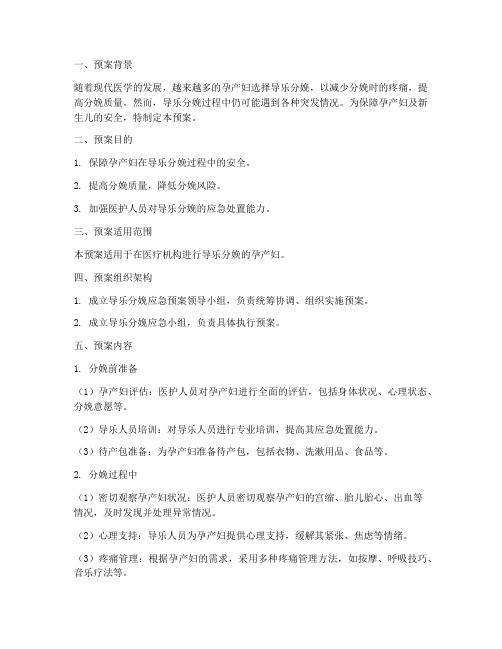
一、预案背景随着现代医学的发展,越来越多的孕产妇选择导乐分娩,以减少分娩时的疼痛,提高分娩质量。
然而,导乐分娩过程中仍可能遇到各种突发情况。
为保障孕产妇及新生儿的安全,特制定本预案。
二、预案目的1. 保障孕产妇在导乐分娩过程中的安全。
2. 提高分娩质量,降低分娩风险。
3. 加强医护人员对导乐分娩的应急处置能力。
三、预案适用范围本预案适用于在医疗机构进行导乐分娩的孕产妇。
四、预案组织架构1. 成立导乐分娩应急预案领导小组,负责统筹协调、组织实施预案。
2. 成立导乐分娩应急小组,负责具体执行预案。
五、预案内容1. 分娩前准备(1)孕产妇评估:医护人员对孕产妇进行全面的评估,包括身体状况、心理状态、分娩意愿等。
(2)导乐人员培训:对导乐人员进行专业培训,提高其应急处置能力。
(3)待产包准备:为孕产妇准备待产包,包括衣物、洗漱用品、食品等。
2. 分娩过程中(1)密切观察孕产妇状况:医护人员密切观察孕产妇的宫缩、胎儿胎心、出血等情况,及时发现并处理异常情况。
(2)心理支持:导乐人员为孕产妇提供心理支持,缓解其紧张、焦虑等情绪。
(3)疼痛管理:根据孕产妇的需求,采用多种疼痛管理方法,如按摩、呼吸技巧、音乐疗法等。
(4)紧急情况处理:如出现胎儿宫内窘迫、胎盘早剥等紧急情况,立即启动应急预案,进行抢救。
3. 分娩后(1)新生儿护理:医护人员对新生儿进行全面的护理,包括脐带结扎、清理呼吸道、评估新生儿状况等。
(2)产后观察:医护人员对孕产妇进行产后观察,包括生命体征、宫缩、出血等情况,及时发现并处理异常情况。
(3)心理疏导:导乐人员为孕产妇提供心理疏导,帮助其适应新角色。
六、应急预案启动条件1. 孕产妇出现严重疼痛,无法忍受。
2. 孕产妇出现胎儿宫内窘迫、胎盘早剥等紧急情况。
3. 医护人员发现孕产妇存在潜在风险。
七、应急预案实施流程1. 发现异常情况,立即报告应急预案领导小组。
2. 应急领导小组启动应急预案,组织应急小组进行救治。
分娩镇痛及导乐陪伴分娩护理常规

分娩镇痛及导乐陪伴分娩护理常规1.参照产时护理常规。
2.由产妇提出申请,助产士初步评估,无分娩镇痛禁忌症者。
3.宫口扩张2~3cm时,先行胎儿监护仪监测胎心20~30min,经产科医生检查排除异常情况,通知麻醉科医生。
4.向患者作好解释工作,麻醉前排空膀胱,开放静脉通路,送产妇到分娩室。
5.连接各种监护仪(心电监护、胎儿监护)进行持续监护。
给予吸氧。
6.协助麻醉师实施麻醉操作,摆好体位,与麻醉师一起核对镇痛药物。
7.实施麻醉过程中,麻醉师严密监测生命体征,助产士及时配合处理。
置管完成后,麻醉师需观察30min。
8.麻醉完毕后,持续胎儿监护,严密观察产程进展及胎心变化,有异常情况通知产科医生。
9.严密监测生命体征及血氧饱和度,定时进行疼痛(VAS)评分和运动功能缺失(下肢)评分,有异常及时通知麻醉师。
10.填写分娩镇痛记录表。
11.第三产程结束后通知麻醉医师拔除麻醉导管。
导乐陪伴分娩护理常规1.产妇提出申请,自宫口扩张2~3cm始,通知导乐师。
由导乐师或经管医生与产妇签订导乐陪伴分娩协议书,同时向家属做自我介绍。
2.在导乐陪伴过程中,向家属及产妇提供相关的信息,做好交流和沟通。
3.为产妇提供温馨、舒适、清洁、安全的分娩环境。
4.导乐师始终陪伴在产妇身边,提供生理、心理、体力。
精神全方位的支持,缓解其紧张和恐惧心理,鼓励产妇建立自然分娩信心,使其以积极的心态度过分娩期。
5.在不同的产程阶段,提供有效的方法和措施缓解疼痛。
6.协助产妇做好进食、饮水、擦汗、排尿等生活护理。
7.关注产程进展和产妇状况,发现异常及时通知经管医生或护士。
平产由导乐者负责接生。
8.产后2小时内关注产妇和新生儿一般情况,协助做好早吸吮。
9.护送母婴回母婴室。
10.若病情需要,需剖宫产手术,导乐师陪伴整个手术过程,直至护送回病房。
产妇分娩的应急预案

一、目的为确保产妇分娩过程中的安全,降低分娩风险,提高分娩质量,特制定本应急预案。
二、适用范围本预案适用于我院所有产妇分娩过程。
三、组织机构成立产妇分娩应急小组,负责应急预案的实施和协调。
组长:产科主任副组长:产科护士长成员:产科医生、助产士、护士、麻醉师、新生儿科医生等。
四、应急预案内容1. 分娩前准备(1)医护人员对产妇进行全面评估,了解产妇的病史、孕产史、家族史等。
(2)告知产妇及家属分娩过程中的注意事项,做好心理疏导。
(3)备齐分娩所需物品,如产包、器械、药品等。
2. 分娩过程(1)严密观察产程,及时发现并处理异常情况。
(2)对有急产史、高危妊娠的产妇,加强监护,严密观察宫缩、胎心、宫口扩张等情况。
(3)正确处理产程,遵循“安全、高效、人性化”的原则。
3. 分娩异常情况处理(1)胎儿窘迫:立即给予吸氧,调整产位,必要时进行剖宫产。
(2)产后出血:迅速建立静脉通路,给予缩宫素、按摩子宫等止血措施,必要时进行子宫动脉结扎或子宫切除术。
(3)软产道损伤:仔细检查并缝合,预防感染。
(4)胎盘植入:及时剥离胎盘,必要时进行清宫术。
4. 新生儿窒息抢救(1)新生儿出生后,立即进行Apgar评分。
(2)对评分低的新生儿,立即给予吸氧、保暖、复苏等处理。
(3)必要时进行气管插管、正压通气等。
五、应急预案实施流程1. 家属呼救:接到家属呼救后,医护人员迅速到场,进行初步评估。
2. 推送产妇:将产妇推送至产房,医护人员准备接产物品及抢救物品。
3. 接产:助产士上台接产,严密观察产程,正确处理异常情况。
4. 分娩后处理:新生儿出生后,立即进行Apgar评分,观察产妇生命体征,做好产后护理。
5. 抢救:如遇分娩异常情况,立即启动应急预案,进行抢救。
六、应急预案培训与演练1. 定期对医护人员进行应急预案培训,提高应对能力。
2. 定期组织应急预案演练,检验预案的可行性和有效性。
3. 对演练过程中发现的问题,及时进行整改。
导乐分娩风险评估及应急处理流程

导乐分娩风险评估及应急处理流程下载温馨提示:该文档是我店铺精心编制而成,希望大家下载以后,能够帮助大家解决实际的问题。
文档下载后可定制随意修改,请根据实际需要进行相应的调整和使用,谢谢!并且,本店铺为大家提供各种各样类型的实用资料,如教育随笔、日记赏析、句子摘抄、古诗大全、经典美文、话题作文、工作总结、词语解析、文案摘录、其他资料等等,如想了解不同资料格式和写法,敬请关注!Download tips: This document is carefully compiled by theeditor.I hope that after you download them,they can help yousolve practical problems. The document can be customized andmodified after downloading,please adjust and use it according toactual needs, thank you!In addition, our shop provides you with various types ofpractical materials,such as educational essays, diaryappreciation,sentence excerpts,ancient poems,classic articles,topic composition,work summary,word parsing,copy excerpts,other materials and so on,want to know different data formats andwriting methods,please pay attention!导乐分娩风险评估与应急处理流程详解导乐分娩,也被称为陪伴分娩,是一种以人性化、自然化为理念的分娩方式。
紧急分娩应急处置预案演练
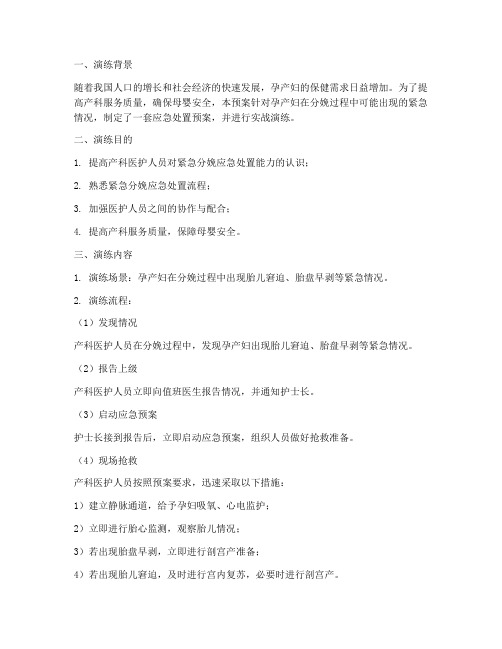
一、演练背景随着我国人口的增长和社会经济的快速发展,孕产妇的保健需求日益增加。
为了提高产科服务质量,确保母婴安全,本预案针对孕产妇在分娩过程中可能出现的紧急情况,制定了一套应急处置预案,并进行实战演练。
二、演练目的1. 提高产科医护人员对紧急分娩应急处置能力的认识;2. 熟悉紧急分娩应急处置流程;3. 加强医护人员之间的协作与配合;4. 提高产科服务质量,保障母婴安全。
三、演练内容1. 演练场景:孕产妇在分娩过程中出现胎儿窘迫、胎盘早剥等紧急情况。
2. 演练流程:(1)发现情况产科医护人员在分娩过程中,发现孕产妇出现胎儿窘迫、胎盘早剥等紧急情况。
(2)报告上级产科医护人员立即向值班医生报告情况,并通知护士长。
(3)启动应急预案护士长接到报告后,立即启动应急预案,组织人员做好抢救准备。
(4)现场抢救产科医护人员按照预案要求,迅速采取以下措施:1)建立静脉通道,给予孕妇吸氧、心电监护;2)立即进行胎心监测,观察胎儿情况;3)若出现胎盘早剥,立即进行剖宫产准备;4)若出现胎儿窘迫,及时进行宫内复苏,必要时进行剖宫产。
(5)转运若孕产妇需要转院治疗,医护人员应立即做好转运准备,包括联系救护车、准备急救药品和设备等。
(6)交接班孕产妇病情稳定后,医护人员应做好交接班工作,详细记录抢救过程和病情变化。
四、演练步骤1. 准备阶段(1)成立演练领导小组,明确各岗位职责;(2)制定演练方案,包括演练时间、地点、场景、流程等;(3)组织参演人员,进行培训和考核;(4)准备演练所需物资,如急救药品、设备、通讯器材等。
2. 演练实施阶段(1)按照演练方案进行实战演练;(2)记录演练过程中存在的问题和不足;(3)参演人员相互评价,总结经验教训。
3. 总结阶段(1)召开总结会议,分析演练过程中存在的问题和不足;(2)针对问题提出改进措施,完善应急预案;(3)组织参演人员撰写个人心得体会。
五、演练要求1. 参演人员应严格遵守演练方案,确保演练顺利进行;2. 演练过程中,各参演人员要密切配合,提高应急处置能力;3. 演练结束后,要及时总结经验教训,完善应急预案;4. 定期开展演练,提高产科医护人员的应急处置能力。
孕妇分娩应急预案模板
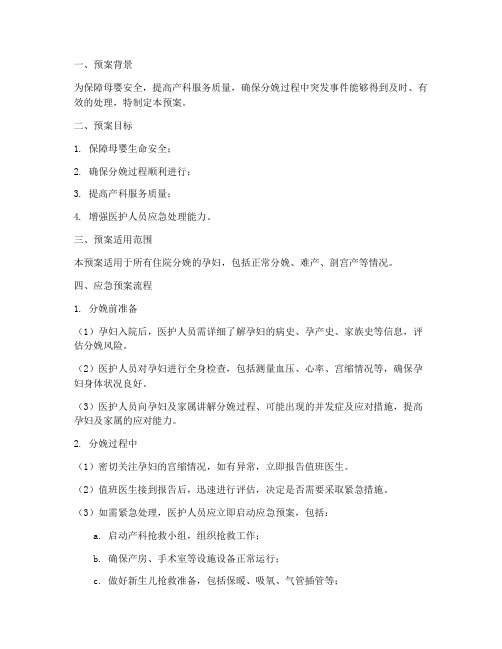
一、预案背景为保障母婴安全,提高产科服务质量,确保分娩过程中突发事件能够得到及时、有效的处理,特制定本预案。
二、预案目标1. 保障母婴生命安全;2. 确保分娩过程顺利进行;3. 提高产科服务质量;4. 增强医护人员应急处理能力。
三、预案适用范围本预案适用于所有住院分娩的孕妇,包括正常分娩、难产、剖宫产等情况。
四、应急预案流程1. 分娩前准备(1)孕妇入院后,医护人员需详细了解孕妇的病史、孕产史、家族史等信息,评估分娩风险。
(2)医护人员对孕妇进行全身检查,包括测量血压、心率、宫缩情况等,确保孕妇身体状况良好。
(3)医护人员向孕妇及家属讲解分娩过程、可能出现的并发症及应对措施,提高孕妇及家属的应对能力。
2. 分娩过程中(1)密切关注孕妇的宫缩情况,如有异常,立即报告值班医生。
(2)值班医生接到报告后,迅速进行评估,决定是否需要采取紧急措施。
(3)如需紧急处理,医护人员应立即启动应急预案,包括:a. 启动产科抢救小组,组织抢救工作;b. 确保产房、手术室等设施设备正常运行;c. 做好新生儿抢救准备,包括保暖、吸氧、气管插管等;d. 做好产妇抢救准备,包括止血、输液、输血等。
3. 分娩后(1)观察产妇的生命体征,如有异常,立即报告值班医生。
(2)值班医生根据产妇情况,决定是否需要进一步治疗。
(3)新生儿出生后,医护人员应立即进行新生儿评估,确保新生儿生命体征稳定。
(4)对产妇及新生儿进行产后护理,确保母婴健康。
五、应急预案保障措施1. 加强医护人员培训,提高应急处理能力。
2. 定期检查、维护产房、手术室等设施设备,确保设施设备正常运行。
3. 配备充足的抢救物资,如氧气、急救药品、新生儿复苏设备等。
4. 制定详细的应急预案演练计划,定期进行演练,提高医护人员应对突发事件的能力。
5. 建立健全应急预案档案,确保应急预案的有效实施。
六、预案总结本预案旨在保障母婴安全,提高产科服务质量。
在实际工作中,医护人员应严格按照预案要求,确保分娩过程顺利进行。
紧急分娩应急处置预案模板
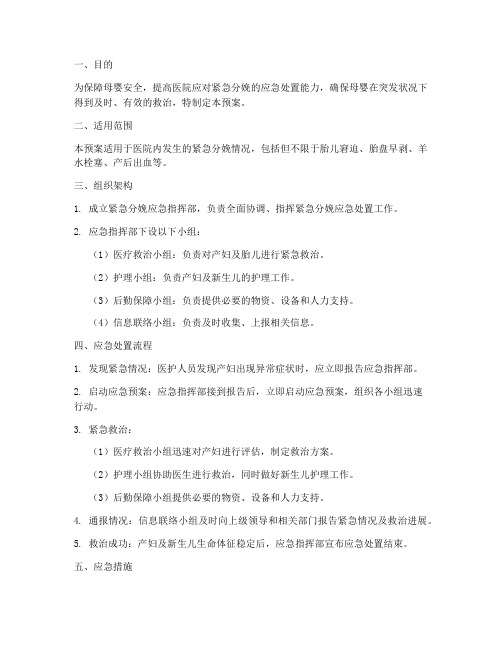
一、目的为保障母婴安全,提高医院应对紧急分娩的应急处置能力,确保母婴在突发状况下得到及时、有效的救治,特制定本预案。
二、适用范围本预案适用于医院内发生的紧急分娩情况,包括但不限于胎儿窘迫、胎盘早剥、羊水栓塞、产后出血等。
三、组织架构1. 成立紧急分娩应急指挥部,负责全面协调、指挥紧急分娩应急处置工作。
2. 应急指挥部下设以下小组:(1)医疗救治小组:负责对产妇及胎儿进行紧急救治。
(2)护理小组:负责产妇及新生儿的护理工作。
(3)后勤保障小组:负责提供必要的物资、设备和人力支持。
(4)信息联络小组:负责及时收集、上报相关信息。
四、应急处置流程1. 发现紧急情况:医护人员发现产妇出现异常症状时,应立即报告应急指挥部。
2. 启动应急预案:应急指挥部接到报告后,立即启动应急预案,组织各小组迅速行动。
3. 紧急救治:(1)医疗救治小组迅速对产妇进行评估,制定救治方案。
(2)护理小组协助医生进行救治,同时做好新生儿护理工作。
(3)后勤保障小组提供必要的物资、设备和人力支持。
4. 通报情况:信息联络小组及时向上级领导和相关部门报告紧急情况及救治进展。
5. 救治成功:产妇及新生儿生命体征稳定后,应急指挥部宣布应急处置结束。
五、应急措施1. 确保急救设备、药品等物资充足,并定期检查、维护。
2. 加强医护人员培训,提高应对紧急分娩的能力。
3. 建立应急物资储备库,确保紧急情况下物资供应。
4. 制定应急预案演练计划,定期开展应急演练。
5. 加强与相关部门的沟通与协作,提高应急处置效率。
六、预案修订本预案自发布之日起实施,如有需要,可根据实际情况进行修订。
七、附则1. 本预案的解释权归应急指挥部所有。
2. 本预案未尽事宜,按国家相关法律法规执行。
- 1、下载文档前请自行甄别文档内容的完整性,平台不提供额外的编辑、内容补充、找答案等附加服务。
- 2、"仅部分预览"的文档,不可在线预览部分如存在完整性等问题,可反馈申请退款(可完整预览的文档不适用该条件!)。
- 3、如文档侵犯您的权益,请联系客服反馈,我们会尽快为您处理(人工客服工作时间:9:00-18:30)。
导乐分娩应急预案及流程
英文回答:
Emergency Protocol and Procedure for Doula-Assisted Labor.
Introduction.
Doula-assisted labor provides support and guidance to pregnant women throughout the labor and birth process. In certain circumstances, emergencies may arise that require prompt and appropriate action to ensure the well-being of the mother and baby.
Emergency Protocol.
Objective: To ensure a safe and timely response to emergencies during doula-assisted labor.
Scope: This protocol applies to all doulas providing
labor support.
Responsibility: The doula is responsible for following the emergency protocol and coordinating with the healthcare team.
Procedure.
1. Assessment and Recognition of Emergency.
The doula should be alert to signs and symptoms that may indicate an emergency, such as:
Severe pain.
Excessive bleeding.
Prolonged labor.
Fetal distress.
Maternal collapse.
If an emergency is suspected, the doula should immediately contact the healthcare provider.
2. Activation of Emergency Response Team (ERT)。
The doula should activate the ERT by informing the healthcare provider and calling for assistance.
The ERT will typically include an obstetrician, midwife, nurses, and other support staff.
3. Monitoring and Support.
While waiting for the ERT to arrive, the doula should continue to monitor the mother and baby.
This may include:
Monitoring vital signs (blood pressure, pulse, temperature)。
Assessing fetal heart rate.
Providing emotional support to the mother.
4. Communication and Documentation.
The doula should communicate all relevant information
to the ERT, including the mother's symptoms, the time the emergency was recognized, and any actions taken.
The doula should also document the incident, including the time, events that occurred, and the names of the healthcare providers involved.
5. Debriefing and Follow-Up.
After the emergency has been resolved, the doula
should debrief with the healthcare team and the mother to discuss the incident and identify any areas for improvement.
The doula should also follow up with the mother and healthcare provider to ensure the mother's well-being and
provide ongoing support.
Training and Certification.
Doulas should receive comprehensive training in emergency management for labor and birth. This training should include:
Recognition of emergency signs and symptoms.
Activation of the ERT.
Monitoring and support of the mother and baby.
Communication and documentation.
Debriefing and follow-up.
Doulas should also maintain current certifications in emergency resuscitation (e.g., CPR, AED).
Conclusion.
By following this emergency protocol, doulas can effectively respond to emergencies during labor and birth. This protocol helps ensure the safety and well-being of the mother and baby by providing a structured and coordinated response.
中文回答:
导乐分娩应急预案及流程。
导言。
导乐分娩为孕产妇的整个分娩过程提供支持和指导。
在某些情
况下,可能会出现紧急情况,需要迅速采取适当的措施来确保母婴
的健康。
应急预案。
目标,确保在导乐分娩期间对紧急情况进行安全和及时的应对。
范围,本预案适用于所有提供分娩支持的导乐。
责任,导乐负责遵循应急预案并与医疗团队协调。
流程。
1. 紧急情况的评估和识别。
导乐应留意可能表示紧急情况的体征和症状,例如:
剧烈疼痛。
大出血。
持续的阵痛。
胎儿窘迫。
产妇昏厥。
如果怀疑出现紧急情况,导乐应立即联系医疗保健提供者。
2. 激活紧急反应小组 (ERT)。
导乐应通过通知医疗保健提供者并寻求帮助来激活 ERT。
ERT 通常包括一名产科医生、助产士、护士和其他支持人员。
3. 监测和支持。
在等待 ERT 到来期间,导乐应继续监测母婴情况。
这可能包括:
监测生命体征(血压、脉搏、体温)。
评估胎心率。
为产妇提供情感支持。
4. 沟通和记录。
导乐应将所有相关信息传达给 ERT,包括产妇症状、发现紧急情况的时间以及采取的任何措施。
导乐还应记录事件,包括时间、发生的事件以及相关医疗保健提供者的姓名。
5. 汇报和后续。
紧急情况解除后,导乐应与医疗团队和产妇讨论事件并找出任何可以改进的地方。
导乐还应对产妇和医疗保健提供者进行后续随访,以确保产妇的健康并提供持续的支持。
培训和认证。
导乐应接受分娩急救管理的全面的培训。
此培训应包括:
识别紧急情况的体征和症状。
激活 ERT.
监测和支持母婴。
沟通和记录。
汇报和后续。
导乐还应在急救复苏方面保持最新的认证(例如,心肺复苏术、AED)。
结论。
通过遵循本应急预案,导乐能够有效地应对分娩期间的紧急情况。
本预案通过提供结构化和协调的响应,有助于确保母婴的安全
和健康。
